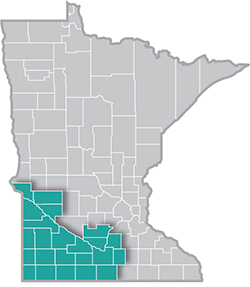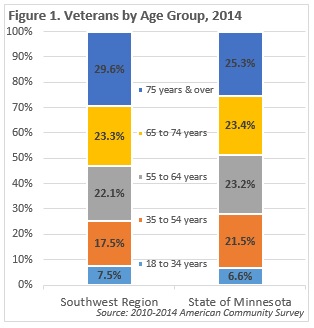 Southwest Minnesota is a national leader in agricultural production, and renewable energy.
Southwest Minnesota is a national leader in agricultural production, and renewable energy.
The region's thriving manufacturing sector includes food processing, machinery, printing, metal products, and computers and electronic products.
Want the freshest data delivered by email? Subscribe to our regional newsletters.
10/28/2016 9:54:04 AM
Luke Greiner
Ron Kellen, veterans employment representative in Southwest Minnesota, has a long history of service to the country, state, and local areas. Kellen started working in employment programs in 1976, and began in the Veterans Employment Program in 1982. His primary duty for the past 18 years has been helping military veterans find jobs.
Located at the WorkForce Center in Worthington, Ron also travels to WorkForce Centers in Hutchinson, Litchfield, Marshall, Montevideo, and Willmar to work with veterans and employers. He has one of two “hybrid” veterans employment positions in Minnesota, combining the duties of both Disabled Veterans Outreach Program (DVOP) and Local Veterans Employment Representative (LVER).
DVOPs work with veterans directly or through referrals on job search techniques, skills identification, resume writing, interviewing, and networking. “While doing this, we have to help the veteran alleviate barriers which may make finding employment difficult,” said Kellen. These barriers include low income, homelessness, criminal background, poor education, or service-connected disabilities.
The main duty of the LVER is to promote hiring veterans, helping to match veterans with job openings through direct contact. “Another important activity is to maintain relationships with community organizations to promote the value of the skills veterans bring to the job, such as leadership, a fast learning curve, maturity, knowledge of advanced technology, teamwork, and the ability to work under pressure, to name a few,” added Kellen.
Helping veterans obtain or improve the skills needed to find meaningful employment is also important. “The best part of my job is when I get a call or an email from a veteran telling me he or she found a job they really love,” said Kellen.
Kellen is excited because 235 new veteran registrations in his service area have received basic job seeking information, including WorkForce Center services, since January 1, 2016. Almost 100 veterans with one or more employment barriers have been served in Kellen’s region this year, and many more benefit from all the assistance available.
According to U.S. Census Bureau data, the 23-county Southwest Minnesota planning region was home to about 29,000 veterans, making up 9.5 percent of the region’s adult population. Data from the Census Bureau’s American Community Survey provides more detail on the demographics of military service members, providing insight into the region.
Like the overall population, the veterans residing in Southwest Minnesota were older than the rest of the state. Nearly 30 percent of the veterans were 75 years and older, compared to 25 percent statewide. Just under 40 percent were between 35 and 64 years of age, about 5 percent lower than the state (Figure 1).

The largest group of veterans – about 10,500 – served in the Vietnam era, while another 6,000 veterans served in the Gulf War eras from 1990 through the present. Just over 4,000 veterans served during the Korean War era, and the region now has less than 3,000 World War II veterans remaining.
Just over 95 percent are male, and about 4.5 percent are female, compared to 5.8 percent in the state. Southwest Minnesota also had less racial diversity than the state, with 98 percent of veterans reporting White alone as their race, 3 percent higher than the state. Every other race group accounted for less than 0.6 percent of veterans, but just over 1 percent of veterans reported Hispanic or Latino origin.
The labor force participation rate for veterans was 4 percent higher in Southwest Minnesota than the state, reaching nearly 82 percent for veterans from 18 to 64 years of age. That meant more than 11,100 veterans in their prime working years were in the workforce in Southwest Minnesota, filling almost 10,500 jobs. The other 670 veterans were actively seeking work but didn’t have a job, leading to an unemployment rate of 6.0 percent for veterans – just over 1 percent higher than the total for all workers.
Veterans were twice as likely to report having a disability as non-veterans, both in the region and across the state, part of the reason for the higher unemployment rates. However, since Southwest had a higher percentage of older veterans, the region also had a higher percentage of veterans with disabilities. Twenty-eight percent of veterans reported having a disability, compared to 12.2 percent of non-veterans.
The state of Minnesota has a wide variety of specialized employment and training services available, ranging from individual employment counseling, to assistance in all stages of job search, to direct referrals for job openings, to job training for disabled veterans, to helping convert military training to civilian credentials.
In Southwest Minnesota, three Veterans Employment Representatives assist veterans and businesses with their employment needs:
In addition, all veterans can use DEED’s website to advance their job search, explore careers and set goals, and use MinnesotaWorks.net, the state’s free online job posting database that allows job seekers to identify themselves as veterans and receive a priority of service.

Contact Luke Greiner at 320-308-5378 or email luke.greiner@state.mn.us or Mark Schultz.